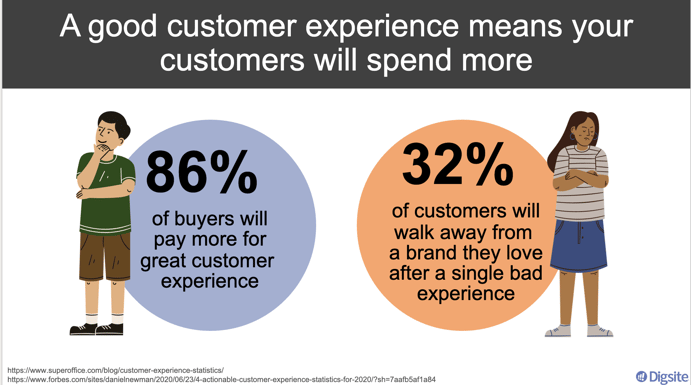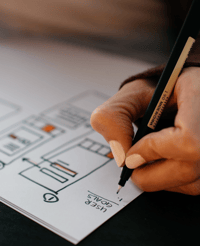Good customer experience is so essential in all aspects of the brand experience and the success of the organization. With in-the-moment feedback about your customers’ expectations and actual experiences interacting with your brand—and more importantly, the context that’s influencing their choices—your organization can discover how to improve the interactions that aren't working for consumers and build upon the ones that are.
In our recent webinar, Digsite CEO Monika Rogers discussed how online qual research tools and methods are making it faster and easier than ever for researchers to tap into their customers' journey and identify growth opportunities. Below, we’re going to talk about the 4 building blocks of good experience journey research projects. In part 2 of the blog, we will share real-world examples of how businesses have used qualitative experience research to successfully address problem areas and create amazing experiences for customers. We also lay out the essential 5 tips for CX research success.
Why is customer experience so important? Data shows that buyers are willing to pay more to have that great customer experience. But sometimes just a single bad experience could make someone walk away. Businesses often know their churn rate and the cost of acquiring that customer, but they don’t know exactly what to do to improve their metrics.

CX journey research is a lot more than just getting a score from people on the scorecard. Think of it as all the ways that customers interact with your company and products to achieve their goals. It is the key to experience innovation. UX more narrowly focuses on improving digital experiences. Whether it’s online, at a physical store, customer service or product delivery, we need to be focused on an accurate understanding of experience journeys to shed some light on the optimal ways to make experiences better.
What are the building blocks of good experience journey research projects?
Use these four building blocks of CX journey research to deliver great outcomes for your projects. They may also help determine how to move forward more iteratively so you can build and optimize solutions as you learn more about the obstacles in the consumer’s journey.
- Persona
- Scope
- Stages
- Obstacles and Emotions
Persona: Understanding who you’re talking to.
With analytics and data, your company probably already has a good handle on their different types of shoppers, buyers or users, and where they’re at in the process. You’ll need to determine the type of user or behavior you want to focus on. Maybe it’s buyers with a specific type of need, or those who have engaged with the category recently. It’s critical to start with a large enough group that your efforts will have a meaningful impact on brand performance. However, the narrower your scope is with that group, the more accurate insights you can gain within that segment of consumers.
Scope: Understanding the journey.
If you look at any process for any organization, whether it's purchase or usage related, you know that some things happen over days or months vs. seconds or minutes. We often have different phases of that experience and are trying to segment the stages of the customer journey, so you’ll need to decide what time frame you want to observe.
We recommend creating studies you can observe in under a week. You can choose consumers in various stages in the journey to cover longer time horizons. The critical factor is making your study iterative, so you can learn, create hypotheses and test them quickly. That does not mean that ongoing journeys aren’t a good option for customer experience research. But keeping your focus narrow on shorter sprints will enable faster decision-making and will give you the ability to iterate on solutions as you learn.
Stages: Understanding the steps within the journey.
You might be looking at a stage where a customer is deciding what brands to put in their consideration set or all the different ways that they become aware and develop consideration. In some cases, you may actually look across the stages from consideration to shopping to usage. You need to decide if you are defining the stages where you need to explore upfront, or if the research itself uncovers those stages. Making wrong assumptions can derail research efforts, so focus on nailing down the stages first and then iterate to drill deeper into the stages you uncover.
Obstacles and Emotions: Understanding pain points and needs.
Friction points or obstacles that people meet through the process is a great place to dig for insights. When does someone reach a point of frustration? At what point in the process does someone get stuck and move on? What delights the customer and makes them enjoy the process? Just remember that identifying where they’re stuck isn’t enough. You need to understand the emotion around that moment and the context of what they’re trying to achieve in order to identify solutions that create a competitive advantage.
There are many techniques to get at understanding these issues. Some are observational – ask a participant to complete a task and share their experience. Others are reflective – ask a participant to share a recent experience and provide pain points or areas of delight. Others are experimental – ask them to create a mock experience and imagine what they might do.
Utilize the best of both worlds.
We believe research is best when you have the flexibility to change directions and customize your data collection to your business needs. While some tech companies live on the extremes – either completely automated data collection or live video interviews – there is a middle ground that gives you the best of both worlds. The right qualitative technology can help you get below the surface without the time and expense of live interviews.
Digsite allows you to capture photos and videos of experiences, then ask fill-in-the-blank stories to help guide participants to share the context and emotion behind their choices. Our experts can act as an extension of your team to recommend projective techniques that bubble up breakthrough insights. And with multiple points of participant engagement, you can iterate as you learn so your research delivers a more accurate understanding of consumer needs.
 Want to learn more about Digsite’s flexible capabilities?
Want to learn more about Digsite’s flexible capabilities?
See the ways you can use Digsite to understand all aspects of the customer journey, including several real-world companies have used Digsite to optimize every moment along the customer journey.




